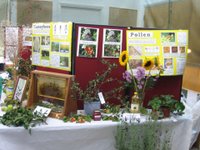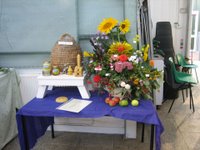The September Apiary Meeting, 'Winter Preparation', turned out to be great fun. I gave the hive tool to Tony who has no bees of his own and said, "get on with it". "What are we looking for ?", he replied. What a good question! We are fast approaching that time of year when there should be little or nothing more that can be done to ensure our colonies have the best chance of surviving winter. The bees have to tough out winter on their own and nothing much can be done to help them out apart from giving them the odd block of candy. So now is the time to get stuck in and make sure they have all they need. We need to estimate the amount of stores present, '30lbs minimum or feed'. Check that we have a laying queen 'look for eggs and young larva', or unite after making absolutely sure that the colony with no brood is in fact Queenless and healthy. Check that the hive is secure on it's stand, that it is bee-tight, and the roof doesn't leak. The mouse guards can go on later when the bees are not so active bringing in the late pollen. Tony did a good job after being instructed how to inspect a frame on both sides AND keep the comb vertical. Congratulations Tony you did very well for your first attempt.
Many thanks to those who gave up some of their time to help out with the Capel Manor 'BEE WORLD' event. It makes my job so much easier when I don't have to scout around to find someone to take over from me for a few minutes while I have a Comfort Break.
The Harvest Supper is on Saturday 7th. October 7.30pm for 8.00pm. carriages at 10.30pm. Please let Daphne know if you are coming so that adequate refreshments can be provided. Raffle Prizes will be appreciated. And don't forget that jar of your best honey to compete for the Skillman Shield.
The November winter meeting will be 'Keeping Hive Records'. How often does one get to their bees and to find that they can't remember exactly what they did last week, and the super the bees needed so desperately has been left behind?



